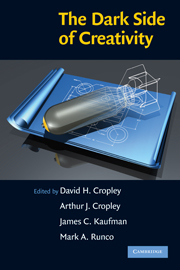Book contents
- Frontmatter
- Contents
- List of Contributors
- 1 The Dark Side of Creativity: What Is It?
- 2 Creativity Has No Dark Side
- 3 Positive Creativity and Negative Creativity (and Unintended Consequences)
- 4 Subjugating the Creative Mind: The Soviet Biological Weapons Program and the Role of the State
- 5 Imagining the Bomb: Robert Oppenheimer, Nuclear Weapons, and the Assimilation of Technological Innovation
- 6 The Innovation Dilemma: Some Risks of Creativity in Strategic Agency
- 7 Early Creativity as a Constraint on Future Achievement
- 8 Boundless Creativity
- 9 Reviewing the Art of Crime: What, If Anything, Do Criminals and Artists/Designers Have in Common?
- 10 Creativity in Confinement
- 11 Creativity and Crime: How Criminals Use Creativity to Succeed
- 12 So You Want to Become a Creative Genius? You Must Be Crazy!
- 13 Both Sides of the Coin? Personality, Deviance, and Creative Behavior
- 14 Neurosis: The Dark Side of Emotional Creativity
- 15 Dangling from a Tassel on the Fabric of Socially Constructed Reality: Reflections on the Creative Writing Process
- 16 Creativity in the Classroom: The Dark Side
- 17 The Dark Side of Creativity and How to Combat It
- 18 A Systems Engineering Approach to Counterterrorism
- 19 Malevolent Innovation: Opposing the Dark Side of Creativity
- 20 Summary – The Dark Side of Creativity: A Differentiated Model
- Index
- References
13 - Both Sides of the Coin? Personality, Deviance, and Creative Behavior
Published online by Cambridge University Press: 05 June 2012
- Frontmatter
- Contents
- List of Contributors
- 1 The Dark Side of Creativity: What Is It?
- 2 Creativity Has No Dark Side
- 3 Positive Creativity and Negative Creativity (and Unintended Consequences)
- 4 Subjugating the Creative Mind: The Soviet Biological Weapons Program and the Role of the State
- 5 Imagining the Bomb: Robert Oppenheimer, Nuclear Weapons, and the Assimilation of Technological Innovation
- 6 The Innovation Dilemma: Some Risks of Creativity in Strategic Agency
- 7 Early Creativity as a Constraint on Future Achievement
- 8 Boundless Creativity
- 9 Reviewing the Art of Crime: What, If Anything, Do Criminals and Artists/Designers Have in Common?
- 10 Creativity in Confinement
- 11 Creativity and Crime: How Criminals Use Creativity to Succeed
- 12 So You Want to Become a Creative Genius? You Must Be Crazy!
- 13 Both Sides of the Coin? Personality, Deviance, and Creative Behavior
- 14 Neurosis: The Dark Side of Emotional Creativity
- 15 Dangling from a Tassel on the Fabric of Socially Constructed Reality: Reflections on the Creative Writing Process
- 16 Creativity in the Classroom: The Dark Side
- 17 The Dark Side of Creativity and How to Combat It
- 18 A Systems Engineering Approach to Counterterrorism
- 19 Malevolent Innovation: Opposing the Dark Side of Creativity
- 20 Summary – The Dark Side of Creativity: A Differentiated Model
- Index
- References
Summary
Rupert Holmes wrote in the musical The Mystery of Edwin Drood (1979), “Would you not quite feel quite the fool of deception/To find the same face on both sides of the coin?.” To elaborate on this a bit, consider Hannibal Lecter's escape from prison in Silence of the Lambs. He attacks and kills two guards. Rather than trying to run, he puts on a guard's uniform, dumps the guard down an elevator shaft, and places the guard's removed face onto his own. The responding officers assume that Lecter is actually the guard and put him in an ambulance – from which he escapes. Lecter is not only evil; he is also amazingly creative. Are his deviant behavior and creativity linked together as common traits, the way that a talented novelist also may write interesting e-mails? Or are they distinct entities in the same manner that a talented novelist also may make excellent birdcalls, cook tasty hash browns, or run a marathon? The relationship between creativity and deviant behavior – with the common ground of personality – is the subject of this chapter.
Personality is an immensely complicated facet of human psychology that is affected by heredity, social ties, environmental factors, biology, and the list goes on. Personality, in turn, affects human behavior in a variety of ways. Keeping Lecter's creative maneuvering in mind, the important questions to consider are (a) Does personality cause deviant behavior? and (b) Can personality predict future likelihood of involvement in criminal behavior?
- Type
- Chapter
- Information
- The Dark Side of Creativity , pp. 235 - 254Publisher: Cambridge University PressPrint publication year: 2010
References
- 7
- Cited by

